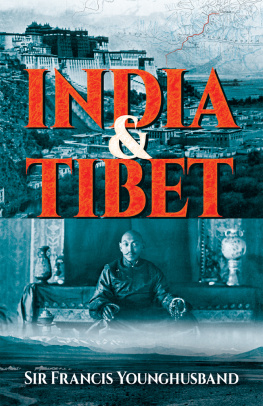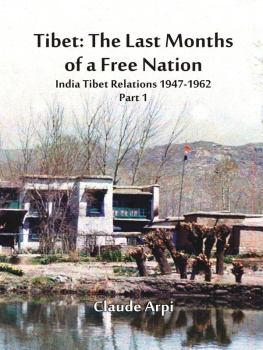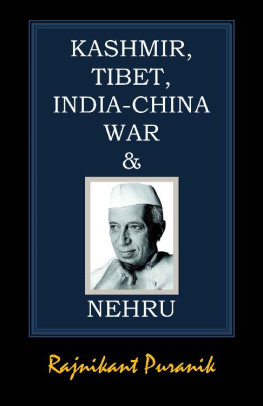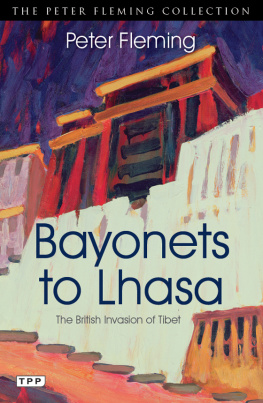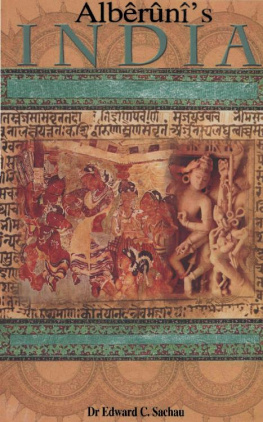PREFACE
A N apology is needed for the length of this book. When it was passing through the press, a Parliamentary Blue-book appeared containing much important information as to recent developments, and what 1 had intended as only the account of our relations with Tibet up to the return of the Mission of 1904 I thought with advantage might be extended to include our relations to the present time. The whole forms one connected narrative of the attempt, protracted over 137 years, to accomplish a single purposethe establishment of ordinary neighbourly intercourse with Tibet. The dramatic ending disclosed is that, when that purpose had at last been achieved, we forthwith abandoned the result.
The reasons for this abandonment have beenfirstly, the jealousy borne by two great Powers for one another ; and, secondly, the love of isolation engrained in us islanders. I have suggested that our aim should be to replace jealousy by co-operation, and, instead of coiling up in frigid isolation, we should expand ourselves to make and keep friendships.
The means I have recommended are living personalities rather than dry treaties, and what Warren Hastings and Lord Curzon wantedan agent at Lhasais to me also the one true means of achieving our purpose.
I am fully conscious of having made mistakes in that part of the conduct of these affairs which fell to me to discharge. The exactly true adjustment of diplomatic with military requirements, and of the wishes of men in England with the necessities of the situation in Tibet, could only be made by a human being arrived at perfection. Not yet having arrived there, I doubtless made many errors. I can only assume that, if I had never made a mistake, I should never have made a success. Likewise, in my recommendations for the future, I may often be in error in detail, but in the main conclusion of substituting intimacy for isolation and effecting the change by personality, I would fain believe I shall prove right.
What I say has no official inspiration or sanction, for I have left the employment of Government, and am seeking to serve my country in fields of greater freedom though not less responsibility; but, in compiling the narrative of our relations with the Tibetans, I have made the fullest use of the four Blue-books which have been presented to Parliament. These contain information of the highest value, though in the very undigested form characteristic of Parliamentary Papers. Beyond personal impressions I have added nothing to them, but merely sought to deduce from them a connected account of events and of the motives which impelled them. To Sir Clement Markhams account of Bogles Mission and Mannings journey to Lhasa, to Captain Turners account of his Mission to Tibet, and to Perceval Landons, Edmund Candlers, and Colonel Waddells accounts of the Mission of 1904, I am also indebted, as well as to Mr. White, Captain Bailey and Messrs. Johnston and Hoffman for photographs.
I lastly desire to acknowledge the trouble which Mr. John Murray has so kindly taken in correcting the proofs.
FRANCIS YOUNGHUSBAND.
September 7, 1910.
P.S.Too late to make use of it, I have received the just published reprint from the Tsung Pao of Mr. Rock-hills The Dalai Lamas of Lhasa and their Relations to the Manchu Emperors of China. The conclusion of this famous authority on Tibet, that the Tibetans have no desire for total independence of China, but that their complaints have always been directed against the manner in which the local Chinese officials have performed their duties, is particularly noteworthy.
CONTENTS
Bhutanese aggression on Bengal in 1772, p. 4. Warren Hastings repels aggression, p. 4. Tashi Lama intercedes on behalf of Bhutanese, p. 5. Warren Hastings replies, proposing treaty of amity and commerce, p. 7. His policy, p. 7. He selects Bogle for Mission, p. 8. His instructions to Bogle, p. 9. Value of discretionary powers to agents, p. 10. Bogles reception by Tashi Lama, p. 13. The Lama acknowledges unjustifiability of Bhutanese action, p. 14. Conversation regarding trade, p. 16. Bogle receives two Lhasa delegates, p. 17. Tibetan fear of the Chinese, p. 18. Bogle suggests alliance with Tibetans against Gurkhas, p. 19. Obstructiveness of Lhasa delegates, p. 20. The Nepalese instigate the Tibetans against Bogle, p. 21. Conversations with Kashmiri and Tibetan merchants, p. 22. Results of the Mission, p. 24.
Warren Hastings further efforts, p. 26. Captain Turner sent to Shigatse, p. 27. Power of the Chinese, p. 28. Admission to traders granted, p. 29. Nepalese invasion in 1792, p. 30. Closing of intercourse with Tibet, p. 31.
Mannings previous career, p. 33. He makes friends with the Chinese, p. 34. Obtains permission from them to visit Lhasa, p. 37. He visits the Grand Lama, p. 37. His stay in Lhasa, p. 38. Results of his journey, p. 39. Subsequent exploration, p. 40.
Bengal Government urge improvement of intercourse with the Tibetans, 1873, p. 42. Press for admission of tea to Tibet, p. 44. Delay caused by reference of local questions to central Governments, p. 45. Colman Macaulays efforts in 1885, p. 46. The Tibetans cross our frontier in force, 1886, p. 47. Neither Chinese nor Tibetan Government can or will withdraw them, p. 48. General Graham expels them, 1888, p. 49.
The Chinese ask that a treaty should be made, p. 50. Convention signed March, 1890, p. 51. Trade Regulations signed December, 1893, p. 52. Tibetans fail to observe Regulations, p. 54. Bengal Government wish to protest, p. 55. Government of India prefer to be patient, p. 55. Tibetans occupy land inside Treaty boundary, p. 56. Efforts to demarcate boundary, p. 57. Tibetans remove boundary pillars, p. 59. Sir Charles Elliott proposes occupation of Chumbi, p. 61. Government of India adhere to policy of forbearance, p. 62. Reasons for Tibetans seclusive policy, p. 63. Chinese fail to arrange matters, p, 64. Report on result of five years working of the Treaty, p. 65.
Attempts by Lord Curzon to open direct communication with Dalai Lama, p. 66. Dalai Lamas Mission to Russia, p. 67. Russian Government disclaim its having political nature, p. 68. Tibetans expelled by us from Giagong inside Treaty boundary, p. 71. Rumours of Russo-Tibetan agreement, p. 72. Reasons why Russian activity in Tibet should cause Indian Government anxiety, p. 73. Indian Government propose sending Mission to Lhasa, p. 76.
Russian protests, p. 79. Lord Lansdownes rejoinder, p. 81. Russian assurances of no intention to interfere in Tibet, p. 82. Such assurances did not preclude possibility of Tibetans relying on Russian support, p. 83.
Views of His Majestys Government on general question, p. 84. Correspondence with Viceroy as to scope of Mission, p. 86. Viceroys proposal to have agent at Gyantse, p. 87. Decision to despatch a Mission to Khamba Jong, p. 87. Correspondence with the Chinese, p. 88. Instructions to the British Commissioner, p. 91. Justification for despatch of Mission, p. 92.


